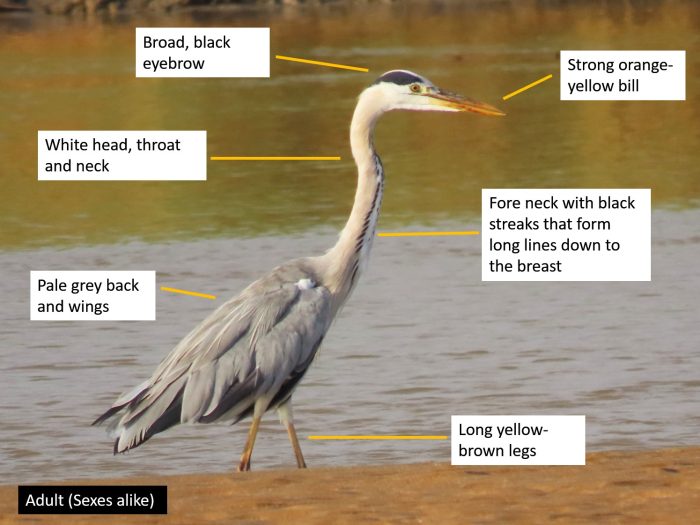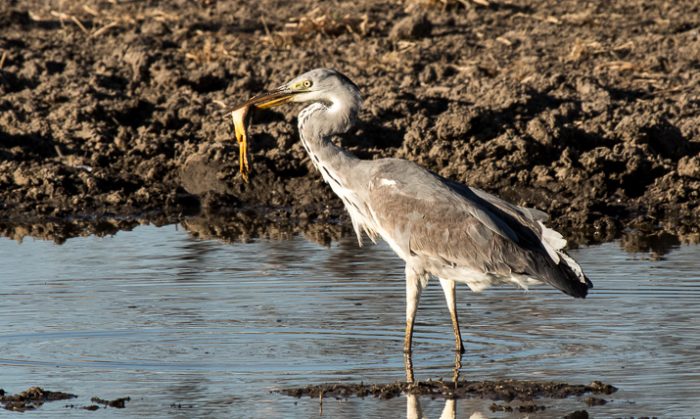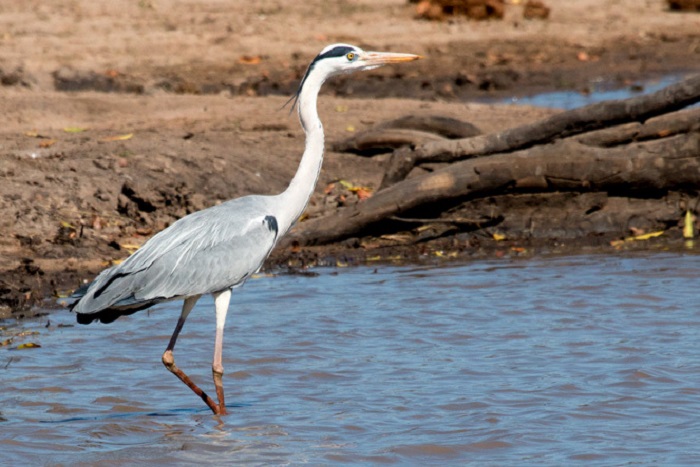Cover image: Grey Heron by Ryan Tippett– Zimanga Game Reserve, KwaZulu-Natal – BirdPix No. 22138
Identification
The Grey Heron is a large, conspicuous and easily identifiable species. The sexes are alike.

St. Lucia Estuary, KwaZulu-Natal
Photo by Malcolm Robinson
Adults in breeding plumage have a white head, nape, throat and neck. The fore neck has a series of black streaks that form a pair of lines ending at the breast. The eyebrow is black and broad, leading to plumes that form a lax crest. The back and tail pale are grey, and the upper wings are pale grey, with black shoulder patches. The underparts are pale greyish-white with pale grey plumes on the breast. The straight, pointed bill is orange-yellow and the eyes are dull yellow. The long legs are yellowish-brown. Non-breeding adults are similar but lack the plumes on the nape and breast.

Middelburg, Eastern Cape
Photo by Tino Herselman
In flight the Grey Heron is seen to have pale grey upper wings with black shoulder patches. From below the wings are uniform dark blueish-grey.

Cape Town, Western Cape
Photo by Dave Rimmer
Juveniles resemble non-breeding adults, but are paler grey with less contrasting colours. The forehead and crown are dark grey and the nape is dull black and they have heavy, dark brown streaking on the throat. Immatures and juveniles also have duller bills with dark grey upper mandibles.

Okavango Delta, Botswana
Photo by Derek Solomon
The Grey Heron most resembles the similarly sized Black-headed Heron (Ardea melanocephala). Confusion is most likely between juveniles, but those of the Grey Heron are distinguished at all ages by the plain grey underwings. The underwings of the Black-headed Heron are contrasting black-and-white.

Piketberg district, Western Cape
Photo by Zenobia van Dyk
Status and Distribution
The Grey Heron is a common resident and local nomad. It is widespread across Eurasia and Africa. The range of the Grey Heron covers most of Africa (excluding the Sahara), Europe and Asia (including India, China, Japan and Indonesia). In Africa it is primarily a Palearctic migrant north of the equator, and a breeding resident to the south.
The Grey Heron occurs throughout most of southern Africa. It is is less common in the drier west where it concentrates at the coast and along major river systems and at isolated water bodies. It is absent from the very arid parts of Namibia, the Kalahari basin and some of the north-western parts of the Northern Cape due to a lack of surface water.

Details for map interpretation can be found here.
The Grey Heron is not threatened locally or globally. A regional range expansion probably occurred during the 20th century, helped by agricultural practices and the construction of artificial water bodies.
Habitat

Kosi Bay, KwaZulu-Natal
Photo by Ryan Tippett
The Grey Heron frequents shallow water bodies in all major habitat types. These include the marine intertidal zone, estuaries, lagoons, rivers, lakes, marshes and pans. It also common at man-made habitats like dams, canals, sewage works and salt works. It is sometimes also found in open grassland near water.

Noordhoek, Western Cape
Photo by Fanie Rautenbach
Behaviour
The Grey Heron is generally found singly or in small groups when hunting, but is colonial when breeding. They are commonly seen standing or wading in shallow water, but sometimes in water deep enough to partially submerge the body.

Velddrif, Western Cape
Photo by Rene Navarro
The Grey Heron is mostly active by day but will also hunt after dark, especially on moonlit nights. It often stands still for long periods while waiting for food to come to them. On occasion it dives for fish from a perch, submerging completely. When prey is sighted, it rapidly extends its neck and strikes, spearing or capturing prey with the bill. Prey is manipulated into a head-first position before being swallowed. Food items are swallowed by jerking the head back and rapidly opening and closing bill. Small items are swallowed alive, while larger prey is shaken or stabbed to death before swallowing. They will discard food items that are too large to swallow.

Mashatu Game Reserve, Botswana
Photo by Derek Solomon
The Grey Heron is predatory and consumes a wide range of animal prey, with fish weighing up to 110 grams being preferred. They will also readily take frogs, large tadpoles, molluscs, crustaceans, worms, insects, turtle hatchlings, eels, snakes, lizards, small rodents and birds. Plant material is rarely eaten. The Grey Heron occasionally steals food from other species like cormorants and is itself a regular victim of kleptoparasitism by African Fish Eagles (Haliaeetus vocifer) and Grey-headed Gulls (Chroicocephalus cirrocephalus).

Garden Route National Park, Western Cape
Photo by Jean Hirons
Grey Herons roosts singly or in groups, usually in trees and sometimes also on cliffs. It flies with the neck pulled into an ‘S’ shape with legs outstretched.
The Grey Heron has been recorded breeding throughout the year but mainly during the summer months. They usually nest colonially and often in mixed-species colonies with other herons, egrets, cormorants, African Darter and storks. They will sometimes also nest singly or in small groups.

Montagu, Western Cape
Photo by Fanie Rautenbach
The nest is a large platform of sticks, lined with grass and is usually placed in the fork of a tree over water. Nests are sometimes also built in reedbeds or rarely, on cliffs or on the ground. The nest is normally constructed by the female with nest material brought to her by the male. Two to four blueish-green eggs are laid per clutch. The incubation period lasts for up to 28 days and is performed by both sexes. The nestling period lasts for a further 30 days or so. Nestlings are fed and cared for by both parents and are able to fly after about 50 days. Juvenile birds become independent after 60 to 70 days.

Manyeleti Nature Reserve, Limpopo
Photo by Vaughan Jessnitz
Further Resources for the African Sacred Ibis
Species text adapted from the first Southern African Bird Atlas Project (SABAP1), 1997.
The use of photographs by Dave Rimmer, Derek Solomon, Fanie Rautenbach, Jean Hirons, Malcolm Robinson, Rene Navarro, Tino Herselman, Vaughan Jessnitz and Zenobia van Dyk is acknowledged.
Virtual Museum (BirdPix > Search VM > By Scientific or Common Name).
Other common names: Bloureier (Afrikaans); uNokilonki (Zulu); Isikhwalimanzi (Xhosa); Blauwe Reiger (Dutch); Héron cendré (French); Graureiher (German); Garça-real (Portuguese)
A list of bird species in this format is available here.
Recommended citation format: Tippett RM 2024. Grey Heron Ardea cinerea. Biodiversity and Development Institute. Available online at https://thebdi.org/2024/02/23/grey-heron-ardea-cinerea/

Middelburg, Eastern Cape
Photo by Tino Herselman

